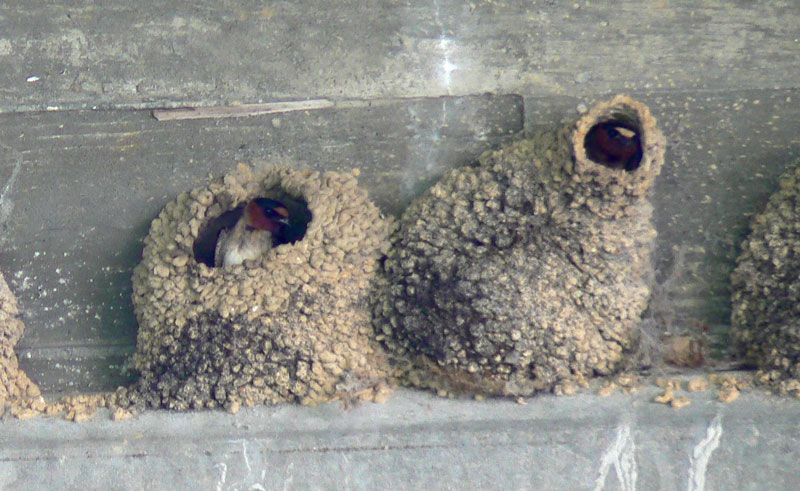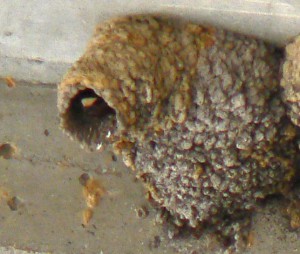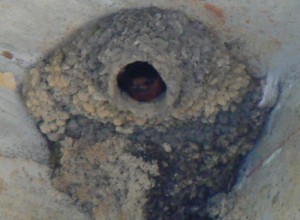
It’s time to revisit the variation in Cliff Swallows along the Gulf Coast – with dark-fronted Cliff Swallows nesting in southern Mississippi and Louisiana. I’m continuing to update the Google map of Cliff Swallow forehead colors, thanks to all who have submitted info and especially Susan Epps, who surveyed many locations on the Gulf Coast and sent the photos in this post. A good overview of these birds and the issues involved is provided by Dittmann and Cardiff (2002)
The dark-foreheaded breeders that occur at some of the coastal Louisiana colonies (e.g., Hwy. 90 at Pearl River, St. Tammany, and Hwy. 82 at Sabine and Mermentau river bridges, Cameron) should be tachina by range, but this has yet to be confirmed. And, to complicate matters, individuals at these colonies exhibit a more or less complete range of variation in forehead color from white, creamy white, beige, tan, and reddish tan to bright rusty and dark chestnut. Whether this variation is the result of hybridization/intergradation between two subspecies remains to be determined. If so, then isolating mechanisms between subspecies with different forehead colors is obviously weak. Some of the variation of forehead color could be the result of hybridization with Barn or Cave swallows, but dark-foreheaded birds do not seem to show any other characters that are intermediate between Cliff and Barn or Cave, and no mixed pairs have so far been reported at Louisiana colonies. (Dittmann and Cardiff, 2002)
One of the interesting facets of this is that Cliff Swallow started nesting in Louisiana in 1978, and the presence of these dark-fronted birds has four possible explanations:
- a relict population that was isolated here in some past millennia and overlooked by birders until 1978
- an isolated breeding outpost colonized by dark-fronted Cliff Swallows from western Mexico
- the result of bybridization with Barn and/or Cave Swallow by the pioneers of these colonies
- a new dark-fronted morph mutation among the pioneers that colonized southern Louisiana and Mississippi
I think the first two options are extremely unlikely, and as Dittmann and Cardiff report there are no indications of hybridization, so the last option – a dark-fronted morph – seems most likely.
But it remains a mystery and deserves more attention from birders. Some of the questions worth investigating:
Continue to map the distribution and percentages of dark-fronted birds in colonies on the Gulf Coast.
Do dark-fronted birds tend to pair with other dark-fronted birds (assortatively) or do they pair randomly?
Do dark-fronted birds occur elsewhere along the Gulf Coast (e.g. coastal Texas) or farther north in Louisiana or Mississippi?
Do dark-fronted birds show any signs of hybridization with either Cave or Barn Swallows – in throat color, back pattern, shape, nest structure, etc?
References
Dittmann, D. and S. Cardiff. 2002. “Let’s take a closer look”- Louisiana Swallows. Part One: “blue-backed, rusty-throated species”. LOS Newsletter 200: 5-12. http://losbird.org/news/0212_200_news.pdf




Thanks David,
These dark-fronted Cliff Swallows have been nesting in coastal Alabama for some time now at several locations (I think going back to the 1990s???). The two forms occur together at nesting colonies and I have personally seen dark-fronted birds paired with white-blazed individuals at a colony under the Dog River bridge in Mobile County.
Interesting subject indeed. Thanks again for sharing this information.
Thanks for this info. Can you estimate of the percentage of dark-fronted birds there?
I have something for everyone to look at in south Louisiana lake Charles pacifically underneath the back porch of the trucking company is it nest it does not allow me to show the pictures but they have seven babies one of them looks weak nobody is going to mess with them it may be a mix it is definitely not a normal bird to be around this area can someone please give me a phone number I can send a picture to
Thanks David,
Sorry the delay in replying. Its been awhile since I checked your website (very useful and informative!!!) so I accidentally missed your response. Unfortunately, I don’t have any quantitative numbers on the proportions of dark-fronted vs pale-fronted birds at the Dog River Bridge site. It has been sometime since I birded the location, so this gives me a good excuse to make a visit. As you probably saw in my recent post this week (on the other Cliff Swallow page) we first documented dark-fronted birds nesting in Alabama back in 1989.
Hope this helps. Thanks for all you do to promote our wonderful natural heritage!
Cheers,
Howard Horne
Mobile, AL
I have a pair nesting on my front porch.
I enjoy watching and hearing them.
I realize they can cause a little mess, but it’s nothing a water hose can’t fix.
I will put up with that to be able to enjoy watching them.
I can take pictures, and provide information, if anyone is trying to track where they are nesting in North Louisiana.
Stefney, Nesting on a front porch sounds more like Barn Swallow behavior. They would have long forked tails (unlike the shorter square tails of Cliff Swallows). They’re nice birds to have either way, and I’m glad you enjoy them. Go ahead and send a photo through my contact page.
I would like your opinion on this odd Cave/Cliff type swallow from Oklahoma. See:
http://www.pbase.com/sloughbirder/cavelike_swallow
They have a bunch in lake Charles la
It’s about 40 of them nesting under a bridge
I discovered a colony of dark fronted swallows at of all places Hollywood Casino in Tunica Mississippi.
They nest on the West exterior wall of the casino. I do not know when they arrive, but I have seen them as early as April and as late as June 27 2014. That was when I left after my last trip. My first sighting was in 2012 just by happenstance. In 2013 I took my camera gear and took some very nice images of the colony. On June 26 and 27 of this year I was back in Tunica with a better set-up and took some rather nice close-ups of a couple of individual nest with young ready to fledge. The adults were still providing their food at a prodigious rate. On the 27 of June when I went to photograph the colony, I noticed one set of nest had disappeared. The nest are in the seven decorative arches on the exterior wall of the building above a small pond adjacent to the wall.
Three years ago we went camping on the Sabine River west of Merryville, Louisiana, under the US 190 bridge, during the week of the 4th of July. It was very entertaining and I shot video and took pictures but I would have to look for them. I could not find anyone that knew what kind of birds they were. They looked just like the ones in the pictures in this posting and the nests were identical.
I would like to see if they are the same type that John posted about being in Lake Charles but he did not give the exact location.
In the last month, April 2016 I have located another colony of Dark Fronted Cliff Swallow, at Two Rivers Park in Little Rock Arkansas. The birds has colonized the East side of the foot bridge spanning from the South bank of the Maumelle River to the main section of Two Rivers Park. The two rivers are the Maumelle River to the South, and the Arkansas River to the North of the peninsula. They are very highly approachable, and totally ignore my presence while I set up and photograph their activities.
I observed dark-fronted and white-fronted Cliff Swallows gathering nesting material and other breeding behavoir at site mapped on this Ebird list (contains photos). http://ebird.org/ebird/view/checklist/S37253521
It is located between two bridges where the Gulf of Mexico (Mississippi Sound) joins the Biloxi Bay in Biloxi, Mississippi (5/29/17)
On March 30, 2018 I observed dark-fronted and other forehead color variations nesting together at site mapped on this Ebird list (contains photos). https://ebird.org/view/checklist/S44096607
This site is located along Bayou Caddy in Bay St. Louis, Mississippi.
https://www.google.com/maps/place/30%C2%B014'16.5%22N+89%C2%B025'27.9%22W/@30.2384288,-89.4280864,401m/data=!3m1!1e3!4m5!3m4!1s0x0:0x0!8m2!3d30.2379149!4d-89.4244111
On June 1, 2019 I observed dark-fronted forehead Cliff Swallows together with white-fronted resting on a wire and feeding near a small bridge on Henderston Point near Pass Christian, Mississippi. Ebird list with photos and site area: https://ebird.org/view/checklist/S56964098
This site is located along the Gulf of Mexico near the entrance to Bay St. Louis, MS
For the last two years I have watched a colony of Cliff Swallows that nest under a walk way in front of a Bealls Outlet store in Sierra Vista Arizona. Some have a pale forehead not white, others are dark orange. Photos posted on EBird, https://ebird.org/view/checklist/S109885329
Here is a dark-fronted Cliff Swallow photographed in North Carolina. A single individual within a colony of “normal” Cliff Swallows. https://ebird.org/checklist/S221123036